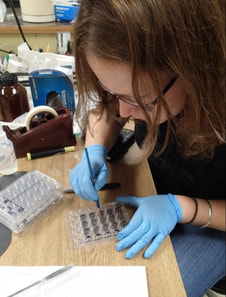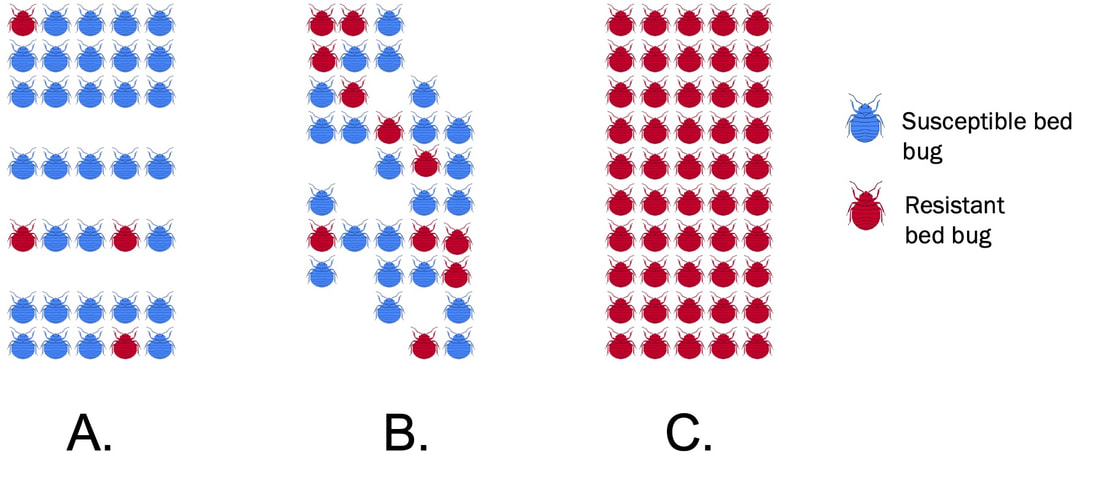|
Scientists talk about the importance of insecticide resistance often, but what is insecticide resistance? How can insecticide resistance be prevented? This week’s blog discusses some insecticide resistance 101, different ways insects survive insecticide exposure, and why you need to know. Bug Lessons regularly advocates for the importance of integrated pest management (IPM) and science-based pest control to effectively manage or eliminate pest problems. Using multiple tools and data-driven treatment decisions to manage pests can reduce chemical insecticide use, which results in fewer environmental contaminates and prolongs the effectiveness of insecticide products. But how? Sometimes when a person uses the same product or active ingredient repeatedly, insecticide resistance can develop. Insecticide resistance is a change in how sensitive insect populations are to a particular insecticide and may result in failure of the product to control the insects. In other words, the insecticide once killed the bugs, but now they walk right through the spray like a gentle rain in May. HOW DO PESTICIDE APPLICATIONS RESULT IN INSECTICIDE RESISTANCE? Certain environments favor the survival of individuals with certain physical and behavioral traits. When a person uses an insecticide to kill insects, some insects may survive exposure because they are naturally different from the majority of the members in their population. These survivors are the ones who reproduce and, ultimately, spread the genes that made them different to new members of the population.
WHAT CAN I DO TO HELP? Insecticides are critical for protecting our food supply, reducing disease transmission, and protecting human and animal health. To preserve these useful tools, carefully consider how and how much insecticides you apply. Science-based pest control or IPM is a multi-step process utilizing all tools available and reasonable and uses data to inform treatment decisions. First, try to monitor pest populations and assess the level of damage before deciding whether the application of an insecticide is necessary. The presence of a pest does not always necessitate action or treatment. However, if treatment is necessary, decide whether other control measures can be employed, such as biological controls (predators/parasites), mechanical control, or sanitation. When applying insecticides, alternate between different insecticide classes if multiple applications are necessary. When choosing different insecticides to include in your program, consider the following:
If you think that you might be dealing with a resistant population of insects, report the problem as soon as possible to a local extension specialist at a nearby university. These folks should be able to help assess whether resistance is present, and if so, what type and what to do. Note that in some cases you might be dealing with ‘tolerant’ versus ‘resistant’ pests. Tolerance is not the same as resistance. Tolerance is a natural tendency and is not related to a tangible, genetic change in the population. For instance, you may see a difference in efficacy of a pesticide against different life stages of a pest. Older life stages of an insect may be more tolerant of insecticide application than younger life stages due to morphological characteristics such as cuticle thickness. Again, an extension specialist can help you tease apart any chemical failures you observe and assess the situation for you if you are unsure. FINAL THOUGHTS Insects and other animals can adapt to changing environments—that is why there is so much diversity in the world. However, their ability to rapidly adapt to change also allows insects to survive exposure to insecticides and become resistant, sometimes within a few generations. The best way to stop resistance is to prevent resistance. Using insecticides thoughtfully and sparingly can help prevent resistance by keeping susceptible members in the environment. For more information and resources on using pesticides more effectively, visit the Pesticide Environmental Stewardship website.
1 Comment
Joe Barile
6/3/2022 04:36:25 am
Jennifer: Thank you for this. With the shift to bioscience for crop pest management the development of new chemistry for urban PM has slowed to a crawl. PMPs need to understand the contribution that IPM provides (including chemistry and formulation rotations) in maintaining a mature portfolio of active ingredients as effective against our target pest arthropods.
Reply
Your comment will be posted after it is approved.
Leave a Reply. |
Bug Lessons BlogWelcome science communicators and bug nerds!
Interested in being a guest blogger?
Archives
November 2023
Categories
All
|

